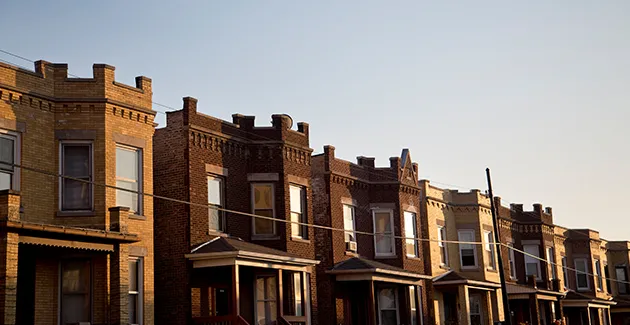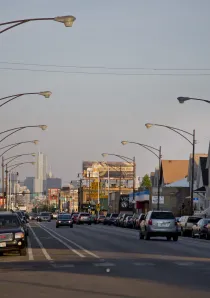The sight of a two-flat apartment is just as familiar to Chicago apartment renters as the city’s vaunted skyscrapers or the shiny edifice of The Bean. These humble homes are one of the most ubiquitous, and affordable, housing types for Chicago apartment renters.
These houses are typically clad in sturdy brick or masonry. A building spree that favored these fire-resistant materials took hold of the city as it roared back from the devastation of the Great Chicago Fire in the late 19th century. Many Chicago two-flats were built off of plans that home builders would select out of a brochure, with little flourishes added here and there as a distinguishing touch, making them similar to the Sears Craftsman homes that have gained a niche, but intensely dedicated, following among architectural enthusiasts.
Two-flats built in the late 19th century and early 20th century permeate almost every corner of the city’s urban sprawl. Their omnipresence may lead many renters and Chicago residents to take them for granted, but there are people who fawn over these buildings that have been called workmanlike or no-fuss homes for the masses.
Chicago Two-Flats Get Two-Dimensional in Ravenswood Artist's Illustrations
One of those appreciative people is Phil Thompson, an illustrator who gained his own dedicated following among fans of Chicago’s architecture. Thompson, more commonly recognized online under the banner of his Wonder City Studio, started producing pen and ink drawings of Chicago homes about 10 years ago. “Vintage homes kept up well just warm the soul,” Thompson says. What started out as a minor obsession with Chicago’s typical homes has gone on to garner this Ravenswood-based artist some national renown. Thompson’s drawings of Chicago houses can be seen on the screen in the film The Big Sick and on Netflix’s Easy, which both take place in Chicago.
Domu asked Thompson a few questions about this quintessential Chicago housing type that he enshrines with his artwork.

Image credit: Wonder City Studio, Phil Thompson
“People who love them, love the fact that they’ve endured the years,” Thompson says of vintage Chicago apartments and homes. And because Chicago was able to maintain such an abundance of historically affordable housing types, like traditional bungalows and two-flats, they gained more fans over the years. Tenants “might have been drawn to the look and feel” initially, Thompson says, “but when they live in it, they often grow to appreciate it even more.” And he would know. Thompson produces custom drawings of individual homes and apartment buildings at a steady pace. The holidays are especially busy for Thompson and he’s usually cranking out commissioned artwork of homes every couple of days.
Old homes definitely engender the warm and fuzzy feelings, but can vintage apartments and homes compare with the creature comforts of all the amenity-rich apartments that have come onto the scene in Chicago’s most recent development boom? “I live in a six-flat built in 1912,” Thompson explains, “and I’m always amazed at how much warmer our place feels compared to places with central air.” Score one for radiator heating, a common feature of the traditional Chicago two-flat, three-flat or six-flat apartment.
“I will admit that...taking the window A/C units in and out does suck,” Thompson concedes. “But overall, the benefits to vintage homes are worth the headaches.” Their charm and undeniable character has helped so many older homes stick around in Chicago’s neighborhoods. But there’s another significant factor that appeals to renters in the tried-and-true Chicago two-flat: affordability.
How Two-Flats Became a Staple of Chicago's Affordable Housing
In their original form, two-flats were an ideal package for aspiring home buyers in that post-Fire and pre-Depression window of Chicago’s history. A spacious home with an efficient layout is going to lure any sensible home buyer. But couple that with the possibility of a rental unit built in? This was a convenient way for homeowners to pay off a mortgage or earn a steady income by operating as small-scale landlords.
While fans of Chicago’s vintage homes like Thompson remain steadfast in their love, the numbers of Chicago’s housing market spell out a concerning picture for two-flats across the city.
Analysis of the Cook County housing market shows the number of 2-to-4 unit apartment buildings decreasing steadily over the last decade. The Institute for Housing Studies at DePaul University measured the decline of 2-to-4 unit residences from 2007 to 2017. The Institute saw a 5 percent decline across Cook County in these traditionally affordable residences, the most significant drop for any housing type that was measured.

The shifting makeup of Chicago apartments in part reflects the changing tastes of its renters. There’s been an influx of more wealthy renters moving to Chicago, which in turn drives down the demand for affordable apartments. These well-heeled renters are more attracted to single family homes or new luxury apartments that carry all the latest amenities and high-end finishings, often coming at the expense of the multi-unit dwellings that used to dominate Chicago’s neighborhoods.
The two-flat and other typically affordable apartments dominated Chicago’s residential architecture for nearly a century. Will the future be as kind to these familiar facets of Chicago’s neighborhoods?




